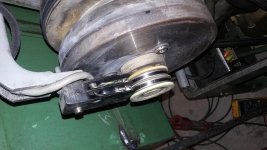58-66cadilac
Plastic
- Joined
- Apr 29, 2013
- Location
- Logandale NV
So, I got a pretty good deal on this LeBlond 14 inch T&D maker; sn# 6HC355; circa 1968; servo shift. That being said, it was not under power when I did the deal, and the fellow I got it from didn't know much about it's history nor Lathes. He picked it up from a fellow out of California who had picked it from his work. Apparently, it was in a production shop to perform a certain task, but the motor went bad so the production shop sent it home with the first fellow.
I've straighten out a few handles that were broke. I have filled the head stock and apron with oil, replaced the ZSS brushes, and finally installed the motor that was provided with the lathe.
I seem to either have the wrong belts or the wrong pulley on the motor. I have frame 213T, I think 215 is the stock motor frame, but they are dimensionally equal from what I can tell, just HP rating is different. my motor pulley is 5 inches in diameter and the belts are 3v710.
If anyone has a tool and die maker, can you send me a pic/deminsions of the motor pulley? I have manual# 3907, it isn't the exact book, but another 90$ to LeBlond right not can't happen until after Christmas. I can turn this pulley down to size, if it is the wrong one, I am just trying to get it working to see if I am going broke saving money....again. LOL George

I've straighten out a few handles that were broke. I have filled the head stock and apron with oil, replaced the ZSS brushes, and finally installed the motor that was provided with the lathe.
I seem to either have the wrong belts or the wrong pulley on the motor. I have frame 213T, I think 215 is the stock motor frame, but they are dimensionally equal from what I can tell, just HP rating is different. my motor pulley is 5 inches in diameter and the belts are 3v710.
If anyone has a tool and die maker, can you send me a pic/deminsions of the motor pulley? I have manual# 3907, it isn't the exact book, but another 90$ to LeBlond right not can't happen until after Christmas. I can turn this pulley down to size, if it is the wrong one, I am just trying to get it working to see if I am going broke saving money....again. LOL George








